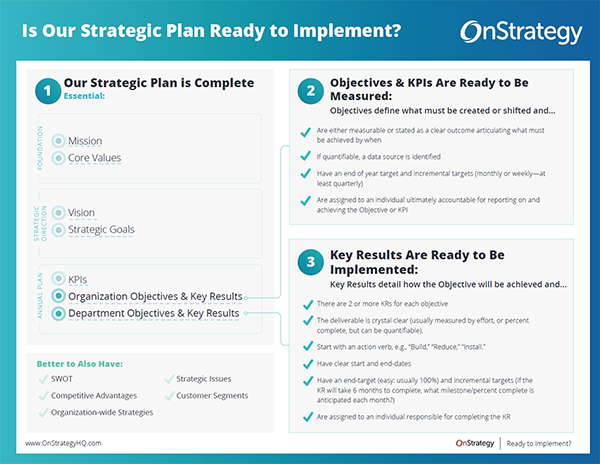Your strategic plan is finally complete; you’ve analyzed the data, prioritized market opportunities, and addressed the strategic issues. You’ve outlined strategic areas of focus, company-wide goals, and KPIs for the next 1-3 years. The only thing left to do is implement… Easy, right?
When you share the strategic plan with your organization, those responsible for executing your carefully designed strategy will be wondering what are the day-to-day outcomes and how they’ll be delivered. It’s human nature for your team to wonder who is in charge of executing and reporting on OKRs and when should OKRs be completed? Folks may look at your big, bold vision and strategic goals and wonder how on earth will you track and report on progress.
Your planning team expects its strategic plan to succeed, but it’s the planning teams’ responsibility to set employees up for implementation success. A plan is not truly implementation-ready unless a few final details are buttoned up:
- SMART Objectives with descriptive Key Results
- OKR Champions
- Start- and end-dates
- Measurements of success (quantitative measures or project progress)
- End-of-year & incremental targets
Let’s walk through the checklist to ensure you’re implementation-ready.
SMART OKRs
Objectives are the company-wide “WHATs”—what needs to be achieved, created or shifted. Objectives are implementation-ready if they are written using SMART language to clearly communicate what must be accomplished in the next 1-3 years to achieve your long-term Strategic Goals. As a refresher:
- Specific (the result or outcome is singular and focused, describing what is different than today)
- Measurable (either in terms of a quantitative measure or in terms of percent complete or progress against key effort milestones)
- Actionable (embedded in the outcome is a crystal-clear action and outcome)
- Responsible (assigns accountability to a person, not a department or a functional area)
- Timebound (details presumed start- and end-dates so the person responsible understands when they’re supposed to begin and complete the OKR)
If you need some tips on setting long-term Strategic Goals and aligned Annual Objectives, check out this article!
Key Results are the “HOWs” that support the “WHAT” (Objective). KRs provide the starting place for your team to achieve the Objectives. KRs break down Objectives into quarterly or monthly initiatives detailing how the objective will be achieved; they also provide leading performance information about an objective’s progress. When you discuss progress of your OKRs at your weekly or monthly performance reviews, KRs help to focus the conversations on how you’re progressing, where you’re stuck and what is needed to get unstuck.
OKR Champions
Who is responsible for what? Every Objective and each KR in your plan needs a champion responsible for managing execution and reporting on progress. Only one, single champion should be identified for each objective and each KR; while OKRs usually take a team to execute, the champion leads the team along the way and reports progress back to Leadership. There’s nothing worse than getting halfway through the year and wondering why your team hasn’t made progress on OKRs—often, the cause is a lack of understanding of who was the champion responsible; then no one advanced the OKRs. The other most common cause of lack of progress is lack of clarity of what the objective’s outcome is and no definition of KRs to guide how to get it done.
Is Your Plan Implementation-Ready?

Start- & End-Dates
OKRs need start- and end-dates to provide timeframes for who is doing what by when, and guardrails for how long we have to achieve the “what” or complete the ”how.” Generally, start- and end-dates should follow the guidelines of the plan structure (e.g., KRs are monthly). Of course, some OKRs may be achieved faster than anticipated; some may hit roadblocks along the way that result in going beyond the anticipated end-date. For this reason, teams should meet monthly or at least quarterly to adjust timing as circumstances shift—because if we’ve learned anything in the past 2 years, man, can circumstances shift.
Check out our video on adopting an agile planning process.
Measurements of Success
Measures allow OKR champions to track and report progress and ensures that there is much less subjectivity about that progress. Generally, there are two types of measures:
- Percent Complete: Used for effort-based or project type OKRs. You will know, by your best managerial estimate, when a goal is 25%, 50%, or 100% complete.*
- Quantitative: Verifiable results based on a relevant data source ($, #, % increase/decrease). When identifying quantitative measures, also identify the data source for a bullet-proof, single source of truth.
*To tighten up the percent complete measure, we often describe progress milestones for each incremental target, e.g., 25% = audit is complete and project objectives are approved; 50% = committee has met at least once and the implementation plan is submitted to leadership.
End-of-Year & Incremental Targets
An end-of-year target sets the target or outcome for the year or term of the multi-year OKR. End-of-year targets are critical to assess what the organization is attempting to accomplish and identifies where you want to be by when.
Incremental targets compare current progress to where progress / performance should be at a point-in-time (not just the end-of-year or completion date of goal). If progress is only assessed at the end of an OKR’s timeframe, there is no room to adjust during implementation and without incremental targets it’s likely you’ll be blindsided at the end of the year by those OKRs that will not be completed when planned—we like surprises for birthdays, but think they’re no bueno in business. Incremental targets (either weekly, monthly or quarterly) provide checkpoints along the way to assess where we should shift resources or focus. If in month 4 of a 12-month OKR, you’re way behind where you thought you would be, have that super interesting and strategic (!) discussion about whether you need to change the approach, change the incremental targets and end-date, or pause the OKR altogether to focus resources.
Pro Tips
- Identify the 1-3 key must-dos (Key Results) to complete each Objective. Start each KR with an action verb (e.g., Create, Build) and clearly articulate successful completion (SMART).
- When identifying KRs, also consider if you have the budget and
capabilities needed to achieve the desired outcome. - After setting champions, consider if any one individual has too many OKRs on their plate. Will they have the time and resources to champion all OKRs, or should ownership be redistributed, or do you need to ‘rack and stack’ that person’s OKRs so that they don’t all start at the same time?
- If an OKR is a team effort, consider assigning contributors. Contributors can outline the team or group responsible for executing the goal. OnStrategy’s App is built to do this easily and without confusing who is the champion and who are the contributors.
- Identify rules/guidelines for target-setting across all goals and you’ll maintain consistency, especially for percent complete OKRs: e.g., all percent complete OKRs will be measured in increments of 10 or 25 percentage points (no increments of 3 ppts!); and set monthly / weekly / quarterly incremental targets to align with your strategy review schedule.
- Your incremental targets must add up to or equal the desired target and measure type communicated in the OKR statement. Matchy-matchy outfits are boring, but articulating the end target in an OKR and having your measure match what the OKR promises is going to avoid confusion:
| Example: | Objective: Achieve an average monthly volume of 200 |
| Target month 1: average monthly volume of 175 | |
| Target month 2: average monthly volume of 180 | |
| Target month 3: average monthly volume of 200 | |
| Target month 4: average monthly volume of 200 | |
| And so on… |
Sure, the last mile of a strategic planning marathon can be challenging with all the needed details, but we see time and again that finishing the marathon with these implementation-ready tips ensures teams are set up to successfully implement their strategy and achieve results, which is really why you started the marathon after all. Check out this handy guide to ensure your strategic plan is implementation-ready and then go crush the targets and conquer the results to achieve your big, bold vision!











